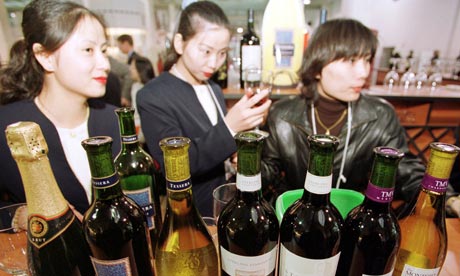
I've often wondered what Chinese tea connoisseurs make of the British cuppa. My mug of Sainsbury's red label must seem a long way from the eighth-century poet Lu Yu's insistence that "the best quality tea must have creases like the leather boot of Tartar horsemen, curl like the dewlap of a mighty bullock, unfold like a mist rising out of a ravine, gleam like a lake touched by a zephyr, and be wet and soft like a fine earth newly swept by rain."
You could be forgiven for thinking the west had the same view about the Chinese way with fine wine: that they just don't know what to do with it. You know the kind of thing I'm talking about: condescending stories about party officials mixing £10,000 bottles of Château Cheval Blanc with lemonade, or tomato juice with Château Margaux. It seems to satisfy a certain strain of sinophobia to think that, no matter how far the Chinese involvement with fine wine goes, they'll never really understand it.
But a country that remains at least nominally communist is now the single biggest force in changing the face of that most powerful symbol of bourgeois European privilege and decadence: fine wine.
Consider the transformation of Hong Kong, which is now the world's second biggest wine auction centre behind New York. Buyers are prepared to spend enormous sums on a handful of big names from Bordeaux, such as a record £60,000 for an Imperial (equivalent to eight bottles) of Château Pétrus last year.
Nick Pegna, managing director of British merchant Berry Bros & Rudd's Hong Kong branch, says the obsession with those big names shows that fine wine consumption in mainland China is even more closely bound to status than it is in the west. "It would be wrong to say wines are not drunk for pleasure, but these wines are usually drunk as part of the business process," Pegna says. And one wine – Château Lafite-Rothschild – trumps all the others.
Quite how Lafite came to be so prized in China is not clear. According to Pegna, explanations range from the linguistic ("La Fay", the Mandarin translation, is easy to say) to the mundanely mercantile (the dominant merchant in the region during the 1980s had a lot of Lafite on its hands).
What is clear, however, is that the Chinese are driving prices of a wine that was never cheap to levels that would stretch even China's reputed 477,000 millionaires. In 1983, a case of 12 bottles of the 1982 vintage was on offer en primeur (sold before the wine is bottled) for £300. The 2009 vintage was offered en primeur this summer for £13,500.
Things are only likely to get worse. The Chinese tend not to stockpile their booty. Instead, they're actually drinking the stuff, which means the stocks of older vintages are diminishing rapidly – so the prices go up.
Perhaps realising they have significantly more demand than they can satisfy, last year Lafite went into partnership with a state-run Chinese investment company, CITIC, to plant more than 60 acres of vines in the promising wine region of Penglai peninsula in Shandong province. The plan – to produce "a Chinese grand cru"– is still a long way from fruition, but when the wine arrives it just might go some way to absorbing the Chinese appetite for all things Lafite. And I for one will be waiting to see if it curls like the dewlap of a mighty bullock or merely gleams like a lake touched by a zephyr.
Six affordable Bordeaux
Reds
The Society's Claret (£5.95, The Wine Society)
Light, dry, a wee bit green, but also succulent and juicy, this is the kind of wine a certain type of posh Brit used to call "a luncheon claret". And, to borrow another slightly archaic posh phrase, it would indeed be just the ticket for a Sunday roast.
Dourthe Barrel Select Montagne St Emilion 2007 (£9.99, Waitrose)
Dourthe is a big company that always does a good job with its various estates and brands around Bordeaux. This is no exception: a lush, modern St-Emilion with some lovely floral hints amid the abundant fruit compote and jam.
Extra Ordinary Claret 2006 (£12.25, Berry Bros & Rudd)
Selected by Jean-Michel Cazes of the celebrated Château Lynch Bages, this is the big brother to Good Ordinary Claret, the St James' Street merchant Berry Bros & Rudd's house Bordeaux. It's not quite as extraordinary as the now-sold out 2005, but it does deliver a lot of very drinkable, ripe, classically Bordelais black fruit and mineral flavours for the money.
Château Chasse-Spleen, Cru Bourgeois Moulis 2005 (£21, Fine+Rare)
2005 was a great vintage in Bordeaux, and, as with 2009, the prices can be absurd. But this beautifully concentrated, carefully oaked classic from a château that regularly punches above its official classification (it's a comparatively lowly cru bourgeois rather than a classed growth) is a relatively inexpensive opportunity to see what all the '05 fuss was about.
White
G de Guiraud Bordeaux Blanc, 2008 (£14.50 or £13.25 as part of a case, Lea & Sandeman)
Bordeaux's fame rests on its reds and sweet whites, but the region has a long tradition of making distinctly individual dry whites, too. This is a full-flavoured, gently oaked, blend of Sauvignon Blanc and Sémillon from a producer better known for its Sauternes, with a long pink grapefruit and honey finish.
Sauternes
Château Filhot, Sauternes Grand Cru Classé, 1999 (£19.99, 375ml, Oddbins)
Sauternes is one of the world's great sweet wines, and this example is a fine, mature, ready-to-drink example of its charms. Lighter and less obviously rich than some, it's zesty with a gorgeous honeyed quality.

